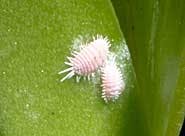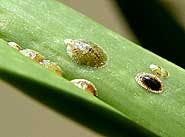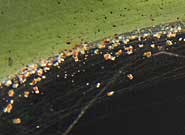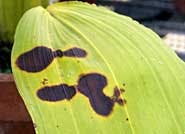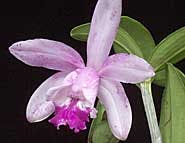Rots & Spots
Wet foliage and high humidity encourages the spread of fungal and bacterial diseases. Bacterial diseases do not respond to fungicides and vice versa so it’s very important to know which disease you are dealing with. Perhaps the easiest way to distinguish between the two is by smell. The most common bacterial disease in orchids produces a foul smell often likened to dead fish. If you’ve ever had cut flowers stand too long in water you know the sort of smell we’re talking about.
Diseases can spread quickly! Bacterial diseases kill plants especially rapidly and time is of the essence. Both bacterial and fungal diseases are spread by splashing water and this includes rainfall. Use a clean cutting tool like a single-edge razor blade, cut off the infected tissue as well as at least an inch of clean, green area and then treat the cut surface with a fungicide. Even if the problem is bacterial, you don’t want a fungal infection to start in the wound. Cinnamon, yes the common spice, is effective against fungal diseases and this can be used to coat the cut surface as well. It’s perhaps not as effective as a chemical fungicide but it’s readily available and does work.
The most common fungal and bacterial rots encountered in orchids include:
Black Rot, a fungal disease characterized by soft, rotted areas that begin on leaves or new growth, then spread to rhizomes and roots. Infected areas are at first a purplish brown, then turn black. The outer margins of the infection site are yellowish.
Black rot can spread quickly through an orchid collection.
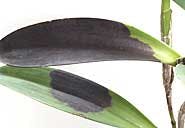
Root Rot, a fungal disease that usually enters the plant through the roots. Infected plants are stunted and wilted. Brown to black areas may extend from the roots into the rhizomes. As the disease advances, leaves will become twisted, wrinkled and yellowish.
Bacterial Brown Spot, a bacterial disease that begins as a sunken, water-soaked lesion on the leaf. Lesions will eventually turn brown or black and exude a dark liquid.
Bacterial rot is typified by a watery lesion on a leaf and is spread by splashing water
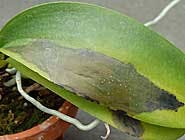
Erwinia, a bacterial disease that begins as a water-soaked, chestnut to chartreuse legion on leaves or pseudobulbs. These legions exude a yellowish liquid with a characteristic foul smell. The disease is most prevalent on plants that are seriously stressed and is a very common problem in Phalaenopsis during hot, prolonged summers.
Leaf Spot, typically fungal diseases that start out as yellow areas on the undersides of leaves. As these spots develop they become visible on both sides of the leaf and turn brown or black.
Cercospora leaf spot on an Oncidium leaf.
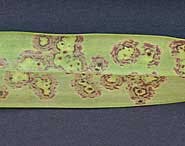
Petal Blight, a common fungal disease favored by high humidity and cool conditions. The disease appears as small circular pink, gray or tan spots that appear on the open flowers. While this disease is not life-threatening to the plant, flowers infected are ruined and unsightly. The disease spreads by arial spores and good housekeeping is essential to control.




